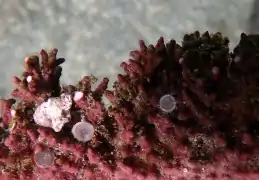Nematocysts
Background
- Jellyfish; box jellyfish is most deadly
- Most toxic: Australia and other Indo-Pacific waters

 Coral reef
Coral reef.jpg.webp) Portuguese Man-O-War {Physalia physalis)
Portuguese Man-O-War {Physalia physalis) A selection of various sea anemones
A selection of various sea anemones
Mechanism

Nematocyst stages of discharge
- Physical contact or osmotic gradient causes discharge of nematocysts
- A spring loaded venom delivery system
- Once opened, a nematocyst releases all of its contained venom
Clinical Features

Skin lesion after contact with the cubomedusa Chiropsalmus quadrumanus jellyfish
- Isolated stinging, pain
- Severe
- Limb paralysis
- Respiratory paralysis
- Cardiovascular collapse
- Death
Irukandji syndrome
- Myalgias, back, chest pain,
- Abdominal pain
- Nausea and vomiting
- Diaphoresis
- Hypertension
- Tachycardia
- Myocardial injury
- Pulmonary edema
Differential Diagnosis
Marine toxins, envenomations, and bites
- Toxins
- Stingers
- Venomous fish (catfish, zebrafish, scorpion fish, stonefish)
- Nematocysts
- Coral reef
- Fire coral
- Jellyfish (Cnidaria)
- Portuguese man-of-war
- Sea anemones
- Seabather's eruption
- Phylum porifera (sponges)
- Bites
- Infections
- Vibrio species in saltwater
- Aeromonas species in freshwater
Evaluation
- Generally a clinical diagnosis
Management
- Remove tentacles and nematocysts
- Hot salt water immersion (inactivates heat labile toxins), submerging the area in 45 ℃ water for 20 minutes has been shown to provide significant pain relief[1]
- Consider topical lidocaine
- Consider oral or parenteral analgesia for severe pain
- Acetic Acid may inhibit or trigger nematocyst discharge and thereby increase or decrease pain depending on species (can use fruit juice or other flavored sodas if vinegar not available)
- It does inhibit nematocyst discharge in the Box Jellyfish species [2]
- Symptomatic treatment for Irukandji syndrome
- Antivenom is available for severe box jellyfish sting
Avoid
- Urine, ethanol, ammonia
- Fresh or tap water (causes nematocyst discharge via the osmotic gradient)
See Also
- Marine toxins and envenomations
- Sea wasp
References
- Ward NT, Darracq MA, Tomaszewski C, et al. Evidence based treatment of jellyfish stings in North America and Hawaii. Ann Emerg Med. 2012;60(4):339-414.
- Cegolon L, Heymann WC, Lange JH, et al. Jellyfish stings and their management: a review. Mar Drugs. 2013;11(2): 523-50
-
- Isbister GK, Currie BJ. Hot water immersion v icepacks for treating pain of Chironex fleckeri stings: a randomised controlled trial. Med J Aust. 2017 Oct 16;207(8):362. PubMed PMID: 29020913.
- Yanagihara AA, Wilcox CL. Cubozoan Sting-Site Seawater Rinse, Scraping, and Ice Can Increase Venom Load: Upending Current First Aid Recommendations. Toxins (Basel). 2017;9(3):105. Published 2017 Mar 15. doi:10.3390/toxins9030105
This article is issued from Wikem. The text is licensed under Creative Commons - Attribution - Sharealike. Additional terms may apply for the media files.